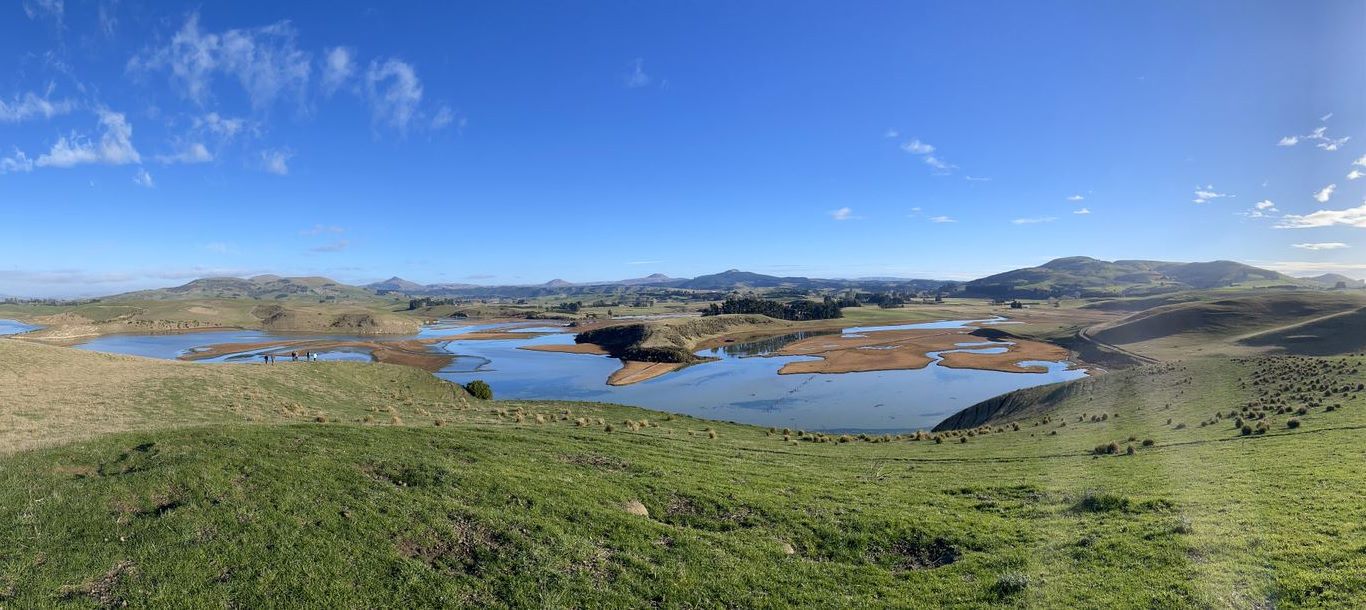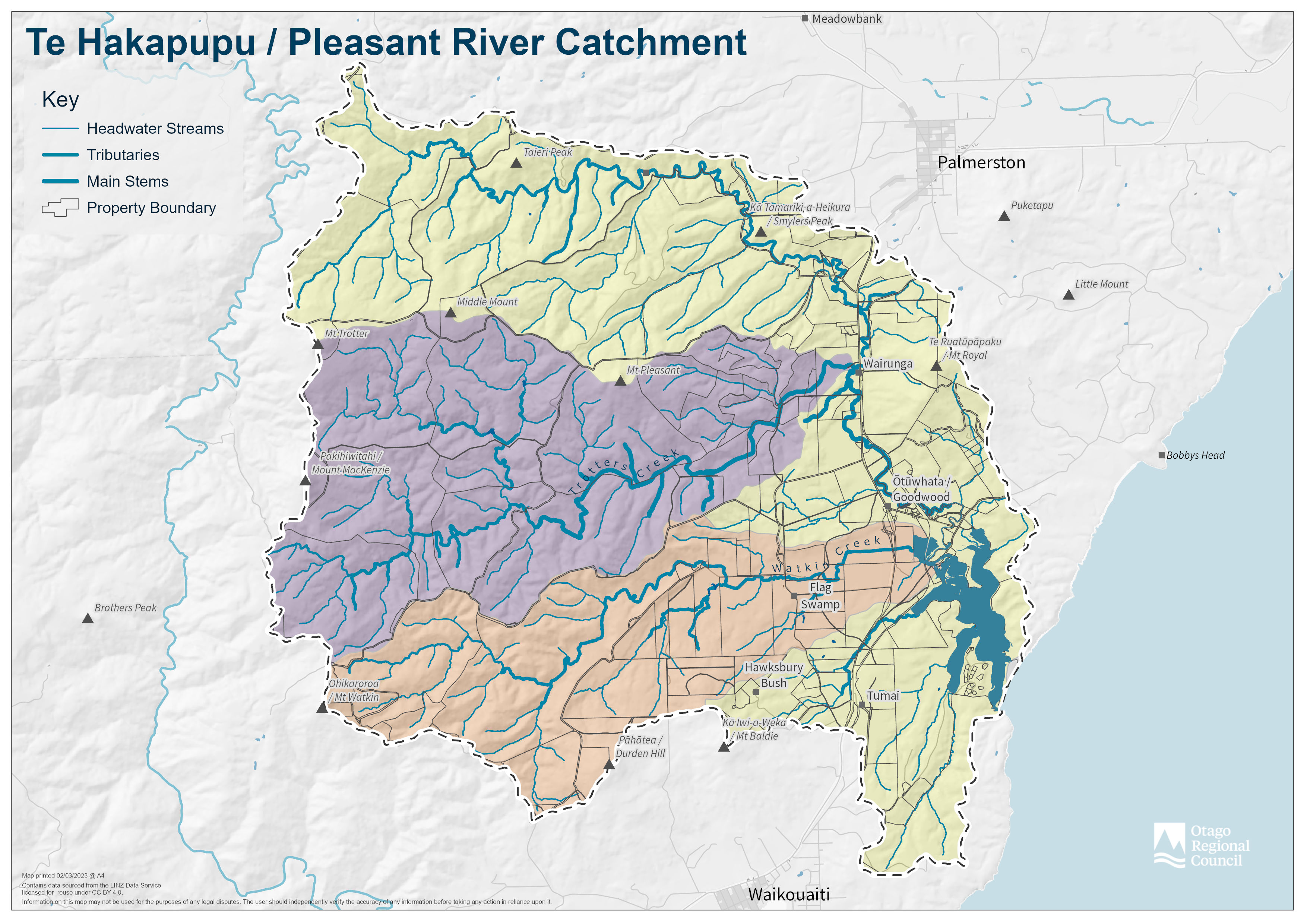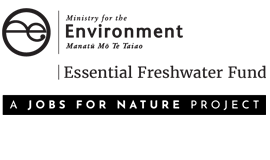-
-
-
-
-
-
-
Toitū Te Hakapupu: The Pleasant River Catchment Restoration Project
-
-
-
July 2021–June 2025
ORC was involved in this project from 2021 through to 2025, and we continue to celebrate the ongoing work by the community.
Toitū Te Hakapupu can be understood to mean "Uplifting the life force and health of the Pleasant River catchment."
This project is a shared commitment to honouring Te Hakapupu’s past, nurturing its present, and supporting its future potential for generations to come
Toitū Te Hakapupu is a partnership project between ORC and Kāti Huirapa Rūnaka ki Puketeraki to restore and enhance the mauri and health of this important East Otago river system. For Kāi Tahu, the river was an important kāika mahika kai (food gathering settlement) where tuna (eels), pātiki (flounders) and īnaka (whitebait) were abundant. Today’s diverse community, whose own history, connection, and livelihood are tied to this catchment, are important collaborators in the success of this project.
Together, this was a journey to create a catchment action plan to inspire us to sustain the awa. The plan will help to enhance the wider ecosystem, improve water quality by reducing the amount of sediment and nutrient input to the rivers and estuary, and use the best of Kāi Tahu mātauraka (knowledge) and modern science to sustain our efforts.

Otago Regional Council and Kāti Huirapa Rūnaka ki Puketeraki have partnered on this project to restore and enhance the mauri and health of this important awa. Among the many aspects of this project Puketeraki have been working on, here are a few to highlight:
Cultural health monitoring
Nine freshwater sites were monitored, and several of these sites hold potential for future cultural use if restoration is prioritised.
This work helps mana whenua understand the cultural health of Te Hakapupu catchment as well as providing an opportunity for whānau to reconnect with their ancestral whenua and awa.
Owhakaoho (Hakapupu Sand Spit) ecological survey and restoration project
Owhakaoho sand spit at the mouth of Te Hakapupu awa/estuary has important biodiversity values and is a culturally significant site for Puketeraki as an early Kāi Tahu occupation and mahika kai site.
Some very exciting finds were katipō spiders, McCann’s and tussock skinks, a godwit landing site and sea lions, to name a few.
There are plans to restore Owhakaoho by regenerating native dune plant communities through weed and pest control, planting and stock exclusion.

Mahere Whenua, Mahere Mauka: Hikaroroa Landscape Plan
Hikaroroa / Mt Watkin is tīpuna mauka — an ancestral mountain — for Puketeraki. Landowners are working with the rūnaka to provide protection to the whole cone, provide access, and improve the native habitat by excluding stock and planting native species. A landscape plan is being developed by Kāti Huirapa Rūnaka ki Puketeraki to guide this process using a combination of historical cultural narratives and contemporary knowledge. This work will also draw on findings from an ecological survey completed by Dunedin City Council, as a contribution to the protection efforts.

92,000 native plants established along waterways and wetlands.
Native plants such as carex, flax, rushes, toetoe and cabbage trees have been planted along waterways to act as filters. The plants trap water contaminants such as nutrients, sediment, and bacteria to help remove them from the waterway. The plants will also stabilise streambanks and create habitat to support improved biodiversity.

39km of fencing has been erected around waterways in the catchment.
This fencing will keep stock out of waterways and wetlands, helping to prevent contaminants from entering the river and reducing streambank erosion.
5 fish passages have been improved. There have also been significant gains in fish passage, opening up 95% of the catchment for migration.
Fish passage can be barred by in-stream structures. Our mission was to remove some of those barriers and give our fish freedom to roam! Three priority culverts in the lower catchment have been replaced, enabling fish passage to upper catchment feeding and breeding areas.
Whitebait monitoring carried out prior to modifications at Brookland’s Road ford found 12 whitebait upstream of the ford. The week following the concrete pour, monitoring found 600 whitebait upstream of the ford!
Before and after the installation of a rock ramp to improve fish passage at the Brookland’s Road ford


10 sediment traps were installed in a priority site to help to reduce the build-up of silt, sand and soil in the downstream river and estuary by trapping it close to the source.
Sediment traps will be monitored and emptied out if necessary. The amount of sediment collected will be estimated. These sediment traps have associated planting on the surrounding slopes to stabilise them over time. Native plants have also been established around and between the traps to capture more sediment and create native habitat.
In the first year, 1,082 m3 of sediment was caught and removed from the sediment traps. That’s 7,220 bathtubs full!

Landowner engagement
This project would not have been possible without the 36 amazing landowners who came on this journey with us, putting in the hours installing fencing on their properties to keep stock out of waterways and planting natives to help stabilise riverbanks and reduce sediment entering the water.
School and community participation
A huge thank you to everyone else who has given a helping hand to the project through community hui and planting days where community came from far and wide. We had so much fun with local schools who helped plant native trees that will be taller than them one day! A special thanks to those who have shown interest in continuing the project’s efforts into the future or assisted with the creation of the Catchment Action Plan that will guide restoration of the catchment for the next 40–50 years.
East Otago Catchment Group
A key collaborator for the project, and not afraid to roll their sleeves up, was East Otago Catchment Group (EOCG). They gave critical support to the project by providing feedback, hosting events — including community meetings and a fish passage field day — and assisting with the culvert replacement to allow fish-friendly passage. EOCG were a vital link for the project and the community.



There are many ways you can protect precious waterways.
Planting, controlling pests and weeds or creating habitat will enhance biodiversity and attract more native animals (birds, lizards, and invertebrates) to your area, improving their chances of survival.
- Take care when applying fertilisers and pesticides
- Plant trees on hills and near streams to reduce land run-off
- Manage stock more efficiently by fencing off streams and waterways to reduce direct water contamination
- Avoid overusing water in dry seasons
- Retire marginal land or change land uses (e.g., pasture to forest)
- Careful planning of subdivisions and urban growth for minimal impact on neighbouring waterways
- Continued removal and control of pests and invasive species including weeds and pest plants
- A plant maintenance guide for landowners and others involved in the project can be found here
Otago Regional Council
Melanie White
Email melanie.white@orc.govt.nz
Soraya Engelken
Email soraya.engelken@orc.govt.nz
Kāti Huirapa Rūnaka ki Puketeraki
Katharina Ruckstuhl
Email katharina.ruckstuhl@otago.ac.nz
East Otago Catchment Group
Steph Scott
Email eocatchmentgroup@gmail.com

Toitū Te Hakapupu newsletter
Sign up to the Toitū Te Hakapupu newsletter for updates on the project and read previous updates.

Science and monitoring
Learn about water quality monitoring, erosion and sediment studies, planting trials and more in Te Hakapupu

Nature-based solutions study
Wai i te reporepo, wai i te wao: what nature tells us about how to understand and prepare for flooding. This Nature-based solutions study will model nature-based methods to find out how they may lessen the effects of flooding and enhance biodiversity. The results will benefit the entire region.

Toitū Te Hakapupu Pleasant River catchment action plan
Help develop a catchment action plan for the Toitū Te Hakapupu Pleasant River catchment. Feedback opened in May 2023, and will remain until the catchment restoration action plan has been finalised (around mid 2025)

Project timeline
Project timeline for Toitū Te Hakapupu: The Pleasant River Catchment Restoration Project.

Events held in the community
Community meetings, planting days, community monitoring and other events.
 The Toitū Te Hakapupu: The Pleasant River Restoration Project is funded by the Ministry for the Environment’s Essential Freshwater Fund through the Government’s Jobs for Nature programme to create jobs while enhancing nature.
The Toitū Te Hakapupu: The Pleasant River Restoration Project is funded by the Ministry for the Environment’s Essential Freshwater Fund through the Government’s Jobs for Nature programme to create jobs while enhancing nature.
Funding of $4 million has been provided to support this $5 million restoration project.


